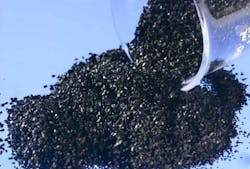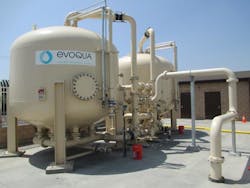There's been a lot of discussion in recent months about the presence of perfluorinated compounds in certain water supplies across the country. Communities, such as Hoosick Falls, N.Y., and Merrimack, N.H., are trying to understand the impacts of these compounds and how to best eliminate them from their water supplies. Evoqua's John Lombardo weighs in on some of the preferred technologies for treating these emerging contaminants.
WATERWORLD: There's been a lot of discussion lately about PFOA and PFOS. What exactly are these compounds?
JOHN LOMBARDO: PFOA and PFOS are perfluorooctanoic acid and perfluorooctane sulfonate, respectively. They are man-made chemical compounds that are subsets of what are called PFCs or perfluorinated compounds. They each contain eight carbons with fluorine attached to them. They were created and mostly used to repel or make things less sticky. It was a main ingredient in products like stain-resistant carpeting, fabrics, and furniture. It was also used on the inside of food packaging and was one of the ingredients in non-stick coatings for cookware.
They are also used as agents in firefighting foams, so they have been used to battle fires and also in firefighting training.
WW: How big of a problem is the presence of perfluorinated compounds in water supplies?
JL: Because these compounds are manmade -- not naturally occurring -- it's only an issue if you are in or near one of the affected areas where they were manufactured or used, a production facility wastewater system, textile manufacturing, furniture manufacturing, any type of municipal or government firefighting training facility; a firefighting training station; air force base; airport; any place where this foam has been sprayed as part of a training exercise and may have seeped into the ground and/or into the water supply.
WW: How much PFOA or PFOS is considered unsafe?
JL: The EPA has not established an official maximum contaminant level (MCL) under the Safe Drinking Water Act. They have established a health advisory limit of 70 parts per trillion individual and/or total PFCs.
WW: Are these compounds still being used or produced?
JL: PFOS was voluntarily phased out of production between 2000 and 2002 by its primary manufacturer, 3M. In 2006, the EPA asked that the remaining producers of PFOA end production of it by the end of 2015, except in certain limited cases where there is no acceptable alternative.
WW: These compounds are quite persistent in the environment. Is there any sense of how long this could continue to be a problem?
JL: There are studies underway but neither the EPA nor the National Institute of Health has a definitive answer on the persistence of perfluorinated compounds. They know that it takes a very, very long time to break down in the body. Unlike some other contaminants, it doesn’t accumulate in fatty tissue; it remains in the bloodstream.
WW: Let's talk about treatment options. What technologies are best for eliminating perfluorinated compounds from drinking water?
JL: There are really three treatment methods. One is high pressure membrane systems -- reverse osmosis -- which can be used to separate and remove the PFCs. The second is ion exchange resin; and the third is, granular activated carbon.
Reverse osmosis or high pressure membrane systems are pressure-driven, so you generate two water streams: a permeate stream (good water) and a concentrate (waste) stream. In desalination, for example, clean drinking water is the permeate. The concentrate, however, is a concentrated liquid stream of what's been removed -- PFOA/PFOS in this case -- that you still have to do something with (e.g., haul it off, have it treated or add another treatment step). So, it's generally not the number one choice for treatment
Evoqua's choice is using granular activated carbon, particularly our Aqua-Carb CX product, which is our coconut shell-based granular activated carbon. In this case, the PFOA or PFOS is adsorbed onto the carbon, and then it stays there. So, as you run the water through the carbon, the compounds stick to the carbon.
When the carbon is exhausted and you start to get breakthrough, the carbon is exchanged. We take it off-site and then we either dispose of it or clean it by reactivating it at very high temperatures and send it back, so that it can be used again.
With ion exchange resin, it is also an adsorption process. The resin would be single-use and then disposed of off-site.
WW: Are these treatment processes affordable?
JL: With reverse osmosis, you have a lot of electricity costs because you have to put in a pump that's able to provide the pressure for the system. You also have tanks and repressurization pumps for the permeate.
A lot of municipalities already have granular activated carbon treatment in their process, so really, as long as there's sufficient empty bed contact time, it could be accomplished by either changing out the carbon media or just adding new, additional, or larger vessels. From a cost perspective, granular activated carbon is a less expensive alternative than reverse osmosis, and that is where most municipalities are going.
WW: Is granular activated carbon encouraged by EPA for removal of PFCs?
JL: It's one of the EPA's recommendations. The agency agrees that high pressure membrane filters or granular activated carbon are really the two methods that they've investigated for removal.
WW: Do you have any advice for a city or town that discovers it has perfluorinated compounds in its water supply?
JL: They need to understand whether it is persistent across all of their water supplies or not. A lot of municipalities have multiple wells that they can draw from. So is the problem affecting just one well or a group of wells? Then they have to decide whether they need to shut down wells.
If shutting down wells is not an option, the next alternative would be for the municipality to see if they could make a connection to an adjacent municipality or water purveyor. If this is not an option, then they are forced to treat the contaminated well(s).
It also depends upon what concentration you've got and the treatment situation. As I mentioned, there isn't an official EPA MCL for the PFCs like there is for other contaminants like arsenic or lead. There's only the lifetime health advisory limit of 70 parts per trillion. If the influent concentration exceeds 100 times the health advisory limit, then treatment is required by the EPA.
That being said, many communities are treating when they exceed the health advisory limit, without an EPA mandate, because they realize it's something they'll have to deal with and they'd rather deal with it now than later.
To learn more about Evoqua's solutions for remediating perfluorinated compounds, visit http://www.evoqua.com/pfcs






